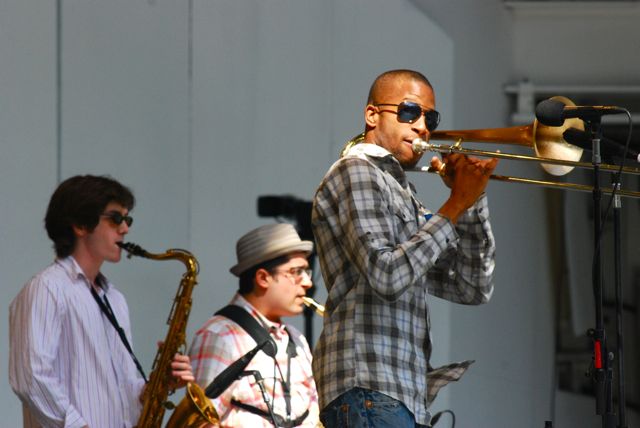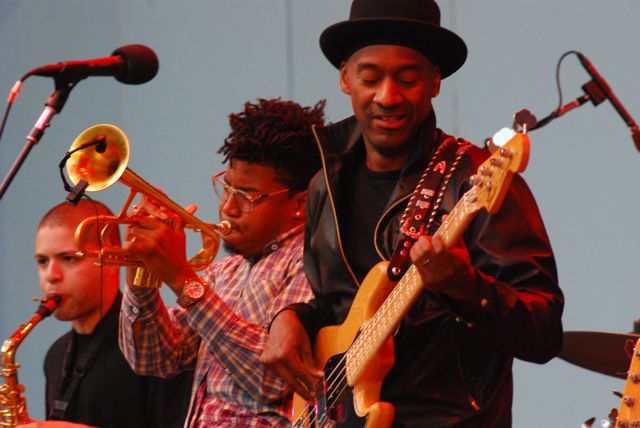Home » Jazz Articles » Live Review » 2010 Playboy Jazz Festival: A Swingin' Party At The Hollywood Bowl
2010 Playboy Jazz Festival: A Swingin' Party At The Hollywood Bowl

Every June since then, Angelenos have become accustomed to kicking off a summer of fun in the sun at Hugh Hefner's mid-June music extravaganza in the hills of Hollywood. And after decades of entertaining at the Playboy Mansion, Hef knows how to throw a party. Music lovers arrive coolers and blankets in hand, ready to stake out their space and settle in for the two day long celebration.
As he has for 29 of the 32 festivals, the inimitable Bill Cosby hosted the weekend's musical program, which opened on Saturday June 12th, with a view into the future of jazz. The El Dorado High School band featured several soloists who gave the music's devotees hope that their young blood, after a bit of seasoning, will soon be ready for infusion into the body and soul of jazz. As their set concluded, the rotating stage, a model of efficiency in presenting music, slowly spun round to reveal Trombone Shorty, a 23 year old rising star who drenched the by now nearly full Bowl with his SupaFunkRock New Orleans sound. His party music worked to perfection, energizing the audience into a handkerchief waving, dancing frenzy.

The next spin of the stage brought forth the Kurt Elling Trio with guest tenor saxophonist, Ernie Watts. Elling, a welcome departure from the cookie cutter vocalists the music industry routinely grinds out, sang several songs from his recent and highly successful tribute to John Coltrane's Ballads recording. His highly personal interpretation of "All Or Nothing At All," supported by Watts' inspired saxing, gave the bacchanalistas a soothing taste of straight ahead jazz. Elling looked to contemporary song writers for his fervent, scatting on Stevie Wonder's "Golden Lady," a potent reminder that not every "standard" pop tune was composed before 1950.
The crowd favorite of the day may have been Naturally 7, a group that makes its music sans instruments. These young, inventive "vocalists" uncannily reproduce the tones and textures of the guitar, trombone, drums and bass, among other instruments, with their voices, and their funky, hip hop style found an eagerly receptive audience at the Bowl.

As the warm sun slowly descended, the revolving stage revealed the Marcus Miller Band. The virtuosic, multi-instrumentalist Miller opened with "Blast," a funked up East Indian raga, highlighted by Miller's propulsive electric bass and the fiery alto sax of 22 year old Alex Han. The set also featured material from Miller's historic collaborations with jazz Olympian, Miles Davis, back in the '80s. Exchanging his bass guitar for a bass clarinet, Miller and friends played the melodic Michael Jackson hit, "Human Nature," before seamlessly slipping into "Tutu," the highly acclaimed Davis recording on which Miller played a Herculean role as composer, arranger, producer and performer. Yet it was the band's cover of the Beatles' "Come Together" that captured the people's attention.
The sun had finally set by the time the Chick Corea Freedom Band hit. But before the music began, another Los Angeles legend, all time basketball great, historian, author, jazz lover and patron, Kareem Abdul-Jabbar came on stage to present Corea with a candle covered cake celebrating the acclaimed keyboard master's 69th birthday. All veteran bandleaders in their own right, alto saxophonist Kenny Garrett, bassist Christian McBride and 85 years young drummer, Roy Haynes, all contributed stellar solos, in addition to complementing Corea during his solo explorations. Truly an all star band, these musicians have played together many times over the years, yet their brilliance clearly went unnoticed by many in the crowd whose intent was to enjoy the festivities rather than appreciate their musical artistry.

Hugh Hefner has proclaimed that the Playboy Jazz Festival is his proudest accomplishment. His festival's stage has not only been graced by all of the music's, it also has given invaluable exposure to many younger musicians.
And yet the Playboy Festival, like so many summertime musical congregations, has so inflated the jazz "tent" in order to appeal to the broadest audience that it begs the question: Why bother to label it a jazz festival at all? It certainly can't be to take maximum advantage of jazz' commercial popularity. After all, according to statistics cited in a recent Jazz Times article, in 2008, jazz accounted for 1.1% of all music sales, a serious decline from the 3.4% of 2001. Further, the average age of concert attendees increased to 46 from 29 in 1983 (Booth, P., June 8, 2010). These trends bode ill for the future of a music often, almost ironically, called America's greatest contribution to world culture. Perhaps the idea of jazz, its hipness, its historical significance, its gravitas, is reflexively desirable to many people who lack the attentional skill and cultural sophistication to organically "connect" with the music. As depressing as these thoughts may be, the joyous communal experience at the Playboy Jazz Festival, and many of the other "jazz" festivals produced around the planet, is reason enough to join the other 18,000 jazz lovers, pack a picnic lunch and head over to the Bowl again next year.
Thanks Hef!
< Previous
Bird Fly By
Next >
La e Ca: Here and There
Comments
Tags
Playboy Jazz Festival
Live Reviews
Chuck Koton
Nina Gordon Public Relations
United States
Stan Getz
Benny Goodman
Count Basie
Art Blakey
Joe Williams
Bill Cosby
trombone shorty
Kurt Elling
ernie watts
John Coltrane
Stevie Wonder
Naturally 7
Marcus Miller
Alex Han
Miles Davis
Michael Jackson
Chick Corea
Kenny Garrett
Christian McBride
Roy Haynes
For the Love of Jazz
 All About Jazz has been a pillar of jazz since 1995, championing it as an art form and, more importantly, supporting the musicians who create it. Our enduring commitment has made "AAJ" one of the most culturally important websites of its kind, read by hundreds of thousands of fans, musicians and industry figures every month.
All About Jazz has been a pillar of jazz since 1995, championing it as an art form and, more importantly, supporting the musicians who create it. Our enduring commitment has made "AAJ" one of the most culturally important websites of its kind, read by hundreds of thousands of fans, musicians and industry figures every month.






















